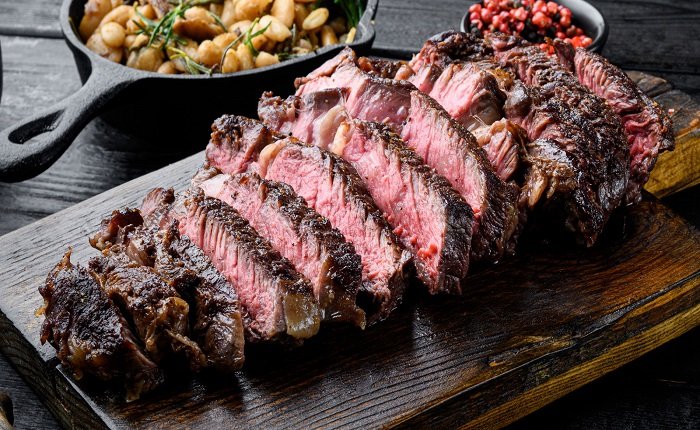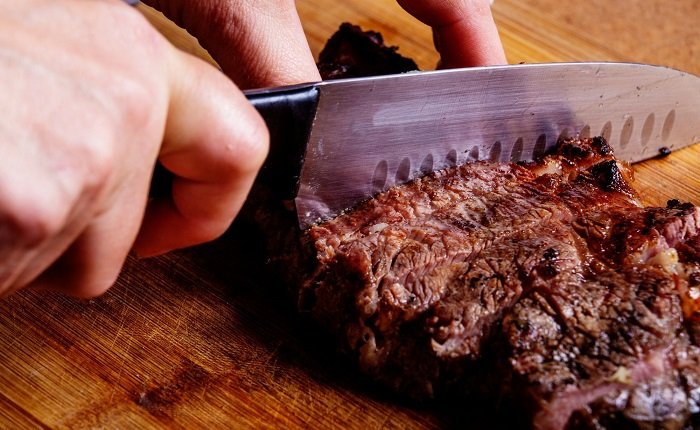Medium Rare Steak: A Culinary Guide to the Perfect Cooked Meat

Medium rare steak represents the pinnacle of steak perfection for many culinary enthusiasts. Achieving the ideal medium rare steak involves understanding the intricacies of meat selection, preparation, and precise cooking techniques. This level of doneness ensures that the steak remains tender, juicy, and flavorful, with a warm red center that melts in your mouth. Whether you’re a seasoned chef or a home cook looking to elevate your steak game, mastering the medium rare steak is essential. This comprehensive guide will delve into everything you need to know about preparing, cooking, and enjoying a perfect medium rare steak, ensuring that every bite is a testament to your culinary skills.
| Steak Cut | Description | Approximate Price Range (USD) |
|---|---|---|
| Ribeye | Known for its rich marbling and flavor. | $15 – $25 per pound |
| Filet Mignon | A tender, lean cut from the tenderloin. | $20 – $30 per pound |
| New York Strip | A flavorful cut from the short loin. | $12 – $22 per pound |
| T-Bone | Combines the strip and tenderloin, separated by a T-shaped bone. | $15 – $25 per pound |
| Sirloin | A leaner cut with a balance of flavor and tenderness. | $10 – $20 per pound |
| Flank Steak | A lean, flavorful cut ideal for marinating. | $8 – $15 per pound |
| Skirt Steak | Known for its rich flavor, often used in fajitas. | $10 – $18 per pound |
| Porterhouse | Similar to T-bone but with a larger tenderloin section. | $18 – $30 per pound |
| Tomahawk | A ribeye steak with a long bone, known for its presentation. | $25 – $50 per pound |
| Wagyu Beef | Renowned for its intense marbling and tenderness. | $100 – $200 per pound |
Selecting the Right Cut for Medium Rare Steak
Choosing the right cut of beef is crucial when aiming for a perfect medium rare steak. Different cuts offer varying textures, flavors, and levels of tenderness, all of which play a significant role in the final outcome. Popular choices for medium rare steak include ribeye, filet mignon, New York strip, and T-bone.
Ribeye is renowned for its abundant marbling, which renders during cooking to create a rich, buttery flavor and a juicy texture, making it an excellent choice for medium rare. Filet mignon, on the other hand, is prized for its unparalleled tenderness, though it has less fat marbling compared to ribeye. This makes filet mignon a leaner option that still delivers a melt-in-your-mouth experience when cooked to medium rare perfection.
New York strip steak strikes a balance between tenderness and flavor, with a firm texture and a robust beefy taste that stands up well to seasoning and high-heat cooking methods. T-bone steaks, which include both a strip steak and a portion of tenderloin, offer versatility and the best of both worlds, catering to those who appreciate both texture and flavor in their medium rare steak.
When selecting your medium rare steak, look for cuts that are at least one inch thick to ensure even cooking. Marbling is a key indicator of quality, as the intramuscular fat will baste the meat during cooking, enhancing both flavor and juiciness. Additionally, choosing grass-fed or organic beef can offer a more complex flavor profile and ensure that your medium rare steak is not only delicious but also ethically sourced.
Preparing Your Steak for Medium Rare Perfection

Proper preparation is essential for achieving the perfect medium rare steak. The process begins with selecting a high-quality cut, as discussed earlier. Once you have your chosen steak, the next steps involve bringing it to room temperature and seasoning it appropriately.
Allowing the steak to sit at room temperature for about 30 minutes before cooking ensures that it cooks more evenly. This step helps prevent the exterior from overcooking while the interior reaches the desired medium rare temperature. Patting the steak dry with paper towels is another critical step, as it removes excess moisture that can hinder the searing process. A dry surface allows for a better Maillard reaction, which is responsible for the steak’s flavorful crust.
Seasoning your medium rare steak properly is also crucial. A simple combination of coarse salt and freshly ground black pepper is often sufficient, as it enhances the natural flavors of the beef without overpowering them. For added depth, you can incorporate garlic powder, onion powder, or your favorite steak seasoning blend. Rubbing the seasoning into the meat ensures that each bite is well-flavored.
If you prefer, marinating your steak can introduce additional flavors and tenderize the meat. However, for a classic medium rare steak, a marinade is not strictly necessary, as the natural flavors of the beef shine through when cooked correctly. Whether you choose to season simply or marinate, the key is to enhance the meat without masking its inherent qualities.
Finally, ensure that your cooking equipment is ready. Preheat your skillet, grill, or oven to the appropriate temperature to create a perfect sear, which is essential for locking in the juices and achieving that coveted medium rare doneness. With these preparation steps completed, you’re well on your way to cooking a medium rare steak that is both delicious and perfectly cooked.
Read more about: vegamovies in
Cooking Techniques for Medium Rare Steak
Achieving the perfect medium rare steak hinges on the cooking technique employed. Several methods can be used, each offering unique advantages and flavors. The most popular techniques include pan-searing, grilling, and sous-vide cooking, each requiring precise temperature control and timing.
Pan-Searing: This method involves cooking the steak in a hot skillet, typically cast iron, with a small amount of oil. The high heat creates a beautiful, caramelized crust on the outside while maintaining a juicy, tender interior. To pan-sear a medium rare steak, heat the skillet until it’s very hot, add a high smoke-point oil like canola or grapeseed, and place the steak in the pan. Sear each side for about 3-4 minutes, depending on thickness, before finishing with butter, garlic, and herbs for added flavor. This technique allows for a quick and controlled cook, making it ideal for achieving a precise medium rare doneness.
Grilling: Grilling imparts a smoky flavor that enhances the natural taste of the medium rare steak. Preheat the grill to high heat, ensuring that the grates are clean and oiled to prevent sticking. Place the steak directly over the heat source, searing each side for a few minutes before moving to a cooler part of the grill to finish cooking. This indirect heat method helps maintain the medium rare temperature while developing a charred exterior. Grilling is perfect for outdoor cooking and adds a distinctive flavor profile that many steak lovers appreciate.
Sous-Vide: Sous-vide cooking involves vacuum-sealing the steak and immersing it in a temperature-controlled water bath. This method ensures precise control over the internal temperature, making it easier to achieve a perfect medium rare steak every time. Cook the steak at 130°F (54°C) for 1-2 hours, then sear it quickly in a hot pan or with a torch to develop a flavorful crust. Sous-vide is ideal for those who prefer hands-off cooking and consistent results, as it eliminates the guesswork involved in traditional cooking methods.
Each of these techniques requires attention to detail and an understanding of heat management to ensure the steak reaches the ideal medium rare doneness. By mastering these methods, you can confidently prepare a medium rare steak that is both flavorful and perfectly cooked.
The Importance of Resting Your Medium Rare Steak
Resting your medium rare steak after cooking is a crucial step that significantly impacts the final texture and juiciness of the meat. When a steak is cooked, the juices are driven towards the center of the meat due to the heat. If you cut into the steak immediately after cooking, these juices will escape, resulting in a drier and less flavorful medium rare steak. Allowing the steak to rest ensures that the juices redistribute evenly throughout the meat, enhancing both its tenderness and flavor.
To rest your medium rare steak properly, remove it from the heat source and place it on a cutting board or a warm plate. Loosely cover it with aluminum foil to retain warmth without causing the steak to steam, which can soften the desirable crust. Let the steak rest for about 5-10 minutes, depending on its size and thickness. This resting period allows the muscle fibers to relax and reabsorb some of the lost moisture, making each bite more succulent and enjoyable.
During the resting phase, the internal temperature of the steak will continue to rise slightly, a phenomenon known as carryover cooking. This means that a medium rare steak will typically reach an internal temperature of around 135-140°F (57-60°C) after resting, ensuring that it remains at the perfect medium rare doneness. Skipping the resting step can compromise the quality of your medium rare steak, so it’s essential to include this step in your cooking process for the best results.
Seasoning and Flavoring Your Medium Rare Steak
Seasoning is a fundamental aspect of preparing a medium rare steak, as it enhances the natural flavors of the beef without overwhelming them. The simplest and most effective seasoning for a medium rare steak is a generous application of coarse salt and freshly ground black pepper. This classic combination draws out the steak’s inherent flavors and creates a savory crust when seared.
For those looking to experiment with additional flavors, there are numerous seasoning options that can complement a medium rare steak. Garlic powder, onion powder, smoked paprika, and dried herbs like rosemary or thyme can add depth and complexity to the meat’s flavor profile. These seasonings can be applied directly to the steak before cooking, allowing them to meld with the beef during the searing process.
Marinating is another method to infuse additional flavors into a medium rare steak. While traditional marinades often involve acidic components like vinegar or citrus juice, which can tenderize the meat, a marinade for medium rare steak should focus more on enhancing flavor without breaking down the muscle fibers excessively. A mixture of olive oil, soy sauce, garlic, and herbs can impart a rich and savory taste to the steak, complementing its natural juiciness.
Compound butters and sauces are excellent additions to a medium rare steak, providing a burst of flavor with each bite. Compound butter, made by mixing softened butter with herbs, garlic, or spices, can be placed on top of the steak just before serving, allowing it to melt and coat the meat. Similarly, sauces like béarnaise, chimichurri, or red wine reduction can elevate the medium rare steak, adding layers of taste that enhance the overall dining experience.
Balancing seasoning and flavoring is key to ensuring that your medium rare steak remains the star of the meal. By thoughtfully applying seasonings and exploring various flavoring techniques, you can create a medium rare steak that is both delicious and memorable.
Cooking Tools and Equipment for Medium Rare Steak
Having the right tools and equipment is essential for cooking a perfect medium rare steak. The quality and type of equipment you use can significantly influence the outcome, ensuring that your steak is cooked evenly and retains its desired doneness.
Skillets and Pans: A heavy-duty skillet, such as a cast-iron pan, is ideal for cooking a medium rare steak. Cast iron retains and distributes heat evenly, providing a consistent sear that locks in the juices and creates a flavorful crust. Non-stick pans can also be used, but they may not achieve the same level of searing as cast iron.
Grills: For those who prefer grilling, a reliable grill with adjustable heat settings is essential. Whether using gas or charcoal, the ability to control the temperature allows for precise cooking, which is crucial for achieving a medium rare steak. Grills also impart a smoky flavor that enhances the taste of the steak.
Meat Thermometer: A digital meat thermometer is a must-have tool for ensuring your medium rare steak reaches the perfect internal temperature of 130-135°F (54-57°C). Instant-read thermometers provide quick and accurate readings, allowing you to monitor the steak’s doneness without guesswork.
Tongs: Using long, sturdy tongs to handle the steak prevents piercing the meat, which can cause juices to escape. Tongs provide a secure grip, making it easier to flip and maneuver the steak during cooking.
Cutting Board and Resting Plate: A sturdy cutting board is necessary for handling the steak before and after cooking. A resting plate, preferably warm, is ideal for letting the medium rare steak rest and redistribute its juices.
Additional Tools: Other useful tools include a meat mallet or tenderizer for ensuring even thickness, a basting brush for applying marinades or compound butter, and a timer to keep track of cooking times accurately.
Investing in quality cooking tools and equipment will make the process of preparing a medium rare steak more efficient and enjoyable. These tools not only enhance the cooking experience but also contribute to achieving consistent and delicious results every time you cook your medium rare steak.
Achieving the Perfect Medium Rare Steak Temperature
Temperature control is paramount when cooking a medium rare steak, as it directly affects the meat’s texture, juiciness, and flavor. Achieving the perfect medium rare doneness involves careful monitoring and precise temperature management throughout the cooking process.
Understanding Doneness: A medium rare steak is characterized by an internal temperature of 130-135°F (54-57°C). At this temperature, the steak is warm and red in the center, with a slightly firmer texture compared to rarer doneness levels. This balance ensures that the steak is tender and juicy, with a rich, beefy flavor.
Using a Meat Thermometer: To accurately gauge the temperature of your medium rare steak, a digital meat thermometer is indispensable. Insert the thermometer into the thickest part of the steak, avoiding contact with bones or fat, which can give inaccurate readings. Monitoring the temperature allows you to remove the steak from the heat just as it reaches the desired medium rare range, preventing overcooking.
Preheating Your Cooking Surface: Whether pan-searing, grilling, or using another method, preheating your cooking surface to the appropriate temperature is crucial. For pan-searing a medium rare steak, the skillet should be extremely hot before adding the steak. This high heat ensures a rapid sear, locking in juices and creating a flavorful crust. Similarly, when grilling, ensure that the grill is preheated to high heat to achieve a good sear before moving the steak to a cooler area for even cooking.
Managing Cooking Time: The thickness of the steak and the cooking method used will influence the cooking time. As a general guideline, a one-inch thick medium rare steak will take about 3-4 minutes per side on a hot skillet or grill. However, using a meat thermometer is the most reliable way to determine doneness, as cooking times can vary based on factors like steak thickness and heat intensity.
Carryover Cooking: Remember that the steak will continue to cook slightly after being removed from the heat, a phenomenon known as carryover cooking. To account for this, consider removing the steak from the heat when it is a few degrees below the target temperature. Letting the steak rest will allow the internal temperature to rise to the perfect medium rare range.
By meticulously managing the temperature throughout the cooking process, you can consistently achieve a perfectly cooked medium rare steak that is both tender and flavorful, making each dining experience a delightful success.
Common Mistakes to Avoid When Cooking Medium Rare Steak

Even with the best intentions, several common mistakes can hinder the achievement of a perfect medium rare steak. Being aware of these pitfalls and knowing how to avoid them is essential for consistent success in your culinary endeavors.
Read more about: cr7s
Overcooking the Steak: One of the most frequent errors is overcooking the steak, resulting in a doneness level beyond medium rare. This can occur due to insufficient temperature monitoring or leaving the steak on the heat for too long. To prevent overcooking, always use a meat thermometer to accurately gauge the internal temperature and remove the steak from the heat source as it approaches the medium rare range.
Underseasoning: Failing to adequately season the steak can lead to a bland and unappetizing medium rare steak. While the natural flavors of the beef are essential, proper seasoning with salt, pepper, and other spices enhances the overall taste. Ensure that the steak is generously seasoned on all sides before cooking to bring out its full flavor potential.
Not Allowing the Steak to Rest: Skipping the resting period after cooking can result in a drier medium rare steak. Resting allows the juices to redistribute throughout the meat, ensuring each bite is juicy and tender. Always allow the steak to rest for 5-10 minutes after cooking before slicing and serving.
Using the Wrong Cooking Surface: Using a thin or non-heat-retentive pan can lead to uneven cooking and prevent the steak from developing a proper sear. For pan-searing a medium rare steak, opt for a heavy-duty skillet like cast iron, which retains and distributes heat evenly, ensuring a consistent cook and a flavorful crust.
Piercing the Steak with Utensils: Using forks or other utensils to turn or handle the steak can cause juices to escape, leading to a less juicy medium rare steak. Instead, use tongs to flip and maneuver the steak, preserving its moisture and enhancing its tenderness.
Cooking Cold Steak: Placing a cold steak directly from the refrigerator onto the heat source can result in uneven cooking, with the exterior overcooked while the interior remains underdone. Allowing the steak to reach room temperature before cooking promotes even heat distribution and helps achieve the desired medium rare doneness.
Ignoring Thickness: Cooking times can vary significantly based on the thickness of the steak. A one-inch thick medium rare steak will cook differently than a two-inch thick one. Always adjust cooking times accordingly and rely on a meat thermometer rather than fixed times to ensure the steak reaches the perfect medium rare temperature.
By avoiding these common mistakes, you can enhance your ability to cook a flawless medium rare steak, ensuring each meal is a delicious and satisfying success.
Pairing Sides and Beverages with Medium Rare Steak
Enhancing your medium rare steak experience involves thoughtfully pairing it with complementary sides and beverages that elevate the meal’s overall flavor and presentation. The right pairings can balance the rich, savory notes of the steak and create a harmonious dining experience.
Classic Side Dishes:
- Mashed Potatoes: Creamy mashed potatoes provide a smooth and comforting contrast to the robust flavors of a medium rare steak. Adding butter, cream, and garlic can enhance their richness.
- Roasted Vegetables: A medley of roasted vegetables, such as asparagus, Brussels sprouts, or carrots, adds color, texture, and a slight sweetness that complements the steak’s savory profile.
- Salads: A fresh green salad with a tangy vinaigrette can offer a refreshing balance to the richness of a medium rare steak. Incorporating ingredients like arugula, cherry tomatoes, and shaved Parmesan adds layers of flavor and texture.
- Creamed Spinach: This indulgent side dish pairs beautifully with a medium rare steak, offering a creamy and flavorful accompaniment that enhances the meal’s overall richness.
Additional Side Options:
- Grilled Mushrooms: Sautéed or grilled mushrooms add an earthy depth to the meal, enhancing the umami flavors of the medium rare steak.
- Onion Rings: Crispy onion rings provide a satisfying crunch and a touch of sweetness, offering a delightful contrast to the tender steak.
- Baked Potatoes: A classic baked potato with toppings like sour cream, chives, and bacon bits can add a hearty and satisfying element to the meal.
Beverage Pairings:
- Red Wine: Bold red wines such as Cabernet Sauvignon, Merlot, or Malbec are excellent choices for pairing with a medium rare steak. Their rich tannins and deep flavors complement the steak’s savoriness.
- Whiskey or Bourbon: A well-chosen whiskey or bourbon can enhance the meal’s flavors, adding complexity and a warming finish.
- Beer: Full-bodied beers like stouts or IPAs can pair well with the robust flavors of a medium rare steak, offering a refreshing counterbalance.
- Non-Alcoholic Options: For those who prefer non-alcoholic beverages, robust teas, sparkling water with a twist of lemon, or a rich apple cider can complement the meal without overpowering it.
Desserts: Concluding the meal with a complementary dessert, such as a chocolate mousse or a creamy cheesecake, can provide a sweet and satisfying finish that balances the meal’s flavors.
By carefully selecting sides and beverages that complement your medium rare steak, you can create a well-rounded and memorable dining experience that highlights the steak’s excellence while providing a diverse array of flavors and textures.
Storing and Reheating Medium Rare Steak
Proper storage and reheating techniques are essential to maintain the quality and flavor of a medium rare steak, especially when dealing with leftovers. Handling the steak correctly ensures that it remains as delicious and tender as when it was first cooked.
Storing Leftovers:
- Cooling: Allow the medium rare steak to cool to room temperature within two hours of cooking. This prevents bacterial growth and preserves the steak’s texture.
- Wrapping: Wrap the steak tightly in aluminum foil or plastic wrap to prevent exposure to air, which can cause the meat to dry out.
- Refrigeration: Store the wrapped steak in an airtight container or a resealable plastic bag in the refrigerator. Properly stored, the medium rare steak can last for 3-4 days.
Reheating Methods:
- Sous-Vide Reheating: This method involves placing the steak in a vacuum-sealed bag and immersing it in a water bath heated to the original cooking temperature (130-135°F or 54-57°C). This gentle reheating process preserves the steak’s tenderness and juiciness without overcooking.
- Oven Reheating: Preheat the oven to a low temperature (around 250°F or 120°C). Place the medium rare steak on a wire rack over a baking sheet to allow even heating. Heat until the internal temperature reaches about 120°F (49°C), then sear it quickly in a hot pan to restore the crust.
- Pan Reheating: Heat a skillet over medium-low heat and add a small amount of oil or butter. Place the steak in the pan and gently reheat, flipping occasionally, until warmed through. Be careful not to overcook, as this can cause the steak to lose its medium rare doneness.
Avoiding Common Pitfalls:
- Microwave Reheating: While convenient, the microwave can quickly overcook the steak, making it tough and dry. If you must use a microwave, reheat the steak on a low power setting and monitor it closely to prevent overcooking.
- Overcooking: Be mindful of the reheating time and method to avoid raising the steak’s internal temperature beyond the medium rare range. Using a meat thermometer can help ensure the steak is heated to the desired temperature without compromising its quality.
By following these storage and reheating guidelines, you can enjoy your medium rare steak even after the initial meal, maintaining its tenderness, juiciness, and rich flavor for days to come.
Health Benefits and Considerations of Medium Rare Steak
Consuming a medium rare steak can offer several health benefits, provided it is part of a balanced and varied diet. Understanding these benefits, as well as the considerations associated with red meat consumption, can help you make informed dietary choices.
Nutritional Benefits:
- High-Quality Protein: Medium rare steak is an excellent source of high-quality protein, essential for muscle growth, repair, and overall body function. Protein from beef contains all the essential amino acids needed by the body.
- Vitamins and Minerals: Steak is rich in essential vitamins and minerals, including iron, zinc, and B vitamins (particularly B12). Iron is crucial for oxygen transport in the blood, zinc supports the immune system, and B vitamins play a key role in energy metabolism.
- Healthy Fats: While medium rare steak contains fat, it includes both saturated and unsaturated fats. The marbling in medium rare steak can provide a source of energy and help in the absorption of fat-soluble vitamins.
Health Considerations:
- Moderation: While medium rare steak offers significant nutritional benefits, it should be consumed in moderation as part of a balanced diet. Excessive red meat consumption has been linked to increased risks of certain health issues, such as heart disease and certain types of cancer.
- Lean Cuts: Opting for leaner cuts of beef can reduce the intake of saturated fats while still providing the benefits of protein and essential nutrients. Cuts like filet mignon or sirloin are excellent choices for those looking to minimize fat intake.
- Cooking Methods: The way medium rare steak is cooked can impact its health benefits. Cooking methods that use excessive oil or lead to the formation of harmful compounds, such as charring, should be minimized. Opting for healthier cooking techniques like pan-searing with minimal oil, grilling with proper temperature control, or sous-vide can preserve the steak’s nutritional value without adding unnecessary fats or harmful chemicals.
- Balanced Diet: Incorporating medium rare steak into a diet that includes a variety of other protein sources, vegetables, fruits, and whole grains ensures a well-rounded nutritional intake. This balance supports overall health and helps mitigate potential risks associated with red meat consumption.
Ethical and Environmental Considerations:
- Sourcing: Choosing beef from ethically raised, grass-fed, or organic sources can have positive implications for both health and the environment. These practices often result in higher-quality meat and support sustainable farming methods.
- Portion Control: Being mindful of portion sizes when consuming medium rare steak can help maintain a healthy diet. A standard serving size is typically around 3-4 ounces, which provides ample protein without excessive calorie intake.
Incorporating medium rare steak into your diet can offer numerous health benefits when done thoughtfully and in moderation. By selecting high-quality cuts, practicing healthy cooking methods, and maintaining a balanced diet, you can enjoy the rich flavors and nutritional advantages of a medium rare steak while supporting your overall well-being.
Conclusion
Mastering the medium rare steak is an art that combines the right ingredients, techniques, and attention to detail. From selecting the perfect cut of beef to achieving precise temperature control and seasoning, each step plays a pivotal role in creating a steak that is tender, juicy, and bursting with flavor. Whether you prefer pan-searing, grilling, or sous-vide cooking, understanding the nuances of each method allows you to consistently produce a medium rare steak that meets your culinary expectations.
The importance of proper preparation, including bringing the steak to room temperature and seasoning it adequately, cannot be overstated. Additionally, the crucial resting period ensures that the steak retains its juices, delivering a succulent and satisfying bite every time. By avoiding common cooking mistakes and utilizing the right tools and equipment, you can elevate your medium rare steak from a simple meal to a gourmet experience.
Pairing your medium rare steak with complementary sides and beverages enhances the overall dining experience, creating a harmonious balance of flavors and textures. Furthermore, being mindful of storage and reheating techniques allows you to enjoy your steak even as leftovers without compromising its quality.
Incorporating medium rare steak into a balanced diet provides not only a delicious meal but also valuable nutritional benefits. By embracing the art of cooking a medium rare steak, you can transform your culinary skills and enjoy one of the most beloved preparations of beef with confidence and finesse.
Whether you’re cooking for yourself, family, or guests, the medium rare steak stands as a testament to culinary excellence. Embrace the process, experiment with flavors, and savor the rich rewards of a perfectly cooked medium rare steak, making every meal a memorable and delightful experience.
FAQs
1. What is the ideal internal temperature for a medium rare steak?
The ideal internal temperature for a medium rare steak is between 130-135°F (54-57°C). Using a meat thermometer ensures accuracy in achieving the desired doneness.
2. Can I cook a medium rare steak on a stovetop?
Yes, pan-searing on a stovetop using a heavy-duty skillet like cast iron is an excellent method for cooking a medium rare steak, providing a flavorful crust and juicy interior.
3. How thick should my steak be to cook medium rare?
A steak that is at least one inch thick is ideal for achieving a medium rare doneness, as it allows for an even cook without overcooking the exterior.
4. Is medium rare steak safe to eat?
Yes, as long as the steak is properly handled and cooked to the correct internal temperature, medium rare steak is safe to consume. Ensure you use high-quality meat and practice good kitchen hygiene.
5. What are some good side dishes to serve with medium rare steak?
Classic side dishes for medium rare steak include mashed potatoes, roasted vegetables, fresh salads, and creamed spinach. These sides complement the rich flavors and enhance the overall meal.




